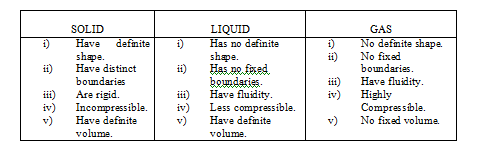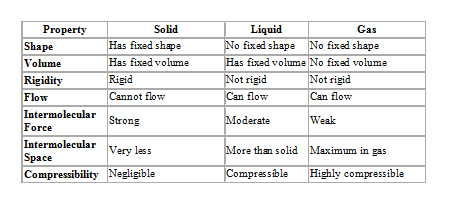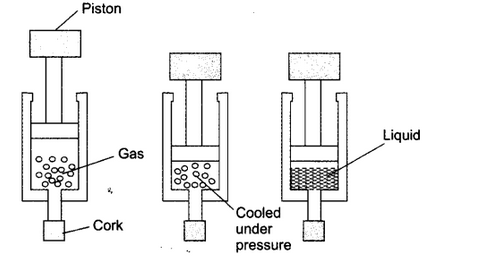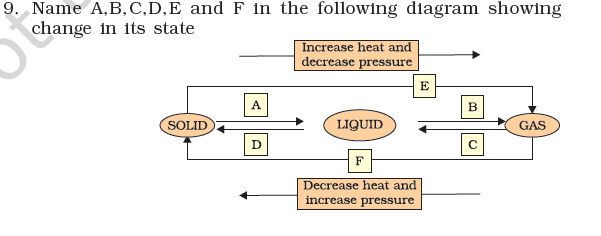NCERT Solutions for Class 9 Science Chapter 1
1. What is matter?
Ans- Matter is a substance that have mass and occupies space. It is made up of tiny particles.
Ex- Air, chalk, sun, planet etc
2. What are the characteristics of particles ?
Ans- The characteristics of particles are:-
i) Particles are continuously moving.
ii) Particles have space between them.
iii) Particles attract each other.
3. How particles of matter are continuously moving ?
Ans- Particles posses kinetic energy. If temperature increase, particles move faster. The movement of particles is less in solid, intermediate in liquid and maximum in gases.
i)Particles have space between them :
When we made lemonade particles of one type of matter gets into the space between the particles of other matter. The space between particles is minimum in solid intermediate in liquid and maximum is gases.
ii) Particles attracted each other: When we open water tap and try to break the stream of the water by hand or finger, water remains together. This shows that the particles of matter attract each other. The force of attraction between the particles is maximum in solid intermediate in liquid and minimum in gas.
3. Characteristics of states of Matter ?
Ans- Characteristics of Matter are :

PAGE NO- 3
Give reasons for the following observations.
Q 1.The small of hot sizzling food reaches you several meters away, but to get the smell from cold food you have to go close.
Ans- The smell of hot sizzling food reaches us several meters away because the particles of hot food posses more kinetic energy. This increased energy cause the particles to move faster and spread out more quickly in the air, which is a process known as diffusion, whereas cold food has less kinetic energy so its particles moves slow and diffuse at a lower rate.
Q 2. A diver is able to cut through water in a swimming pool. Which property of matter does the observation show?
Ans- A diver is able to cut through water in a swimming pool because the particles of water have intermolecular space and weak force of attraction, allowing movement through them.
Q 4.What are the characteristics of the particles of matter?
Ans- The characteristics of the particles of matter are :-
i) Have intermolecular space.
ii) They attract each other.
iii) The particles are continuously moving.
PAGE NO- 6
Question 1. The mass per unit volume of a substance is called density. (density = mass/volume). Arrange the following in order of increasing density: air, exhaust from chimneys, honey, water, chalk, cotton and iron. please explain
Ans- To arrange the substances in increasing order of density, we compare how tightly packed their particles are.
Order (from least to greatest density):
Air < Exhaust from chimneys < Cotton < Water < Honey < Chalk < Iron
Question 2. (a) Tabulate the differences in the characteristics of states of matter.
Ans- Differences in the Characteristics of States of Matter

(b) Comment upon the following: rigidity, compressibility, fluidity, filling a gas container, shape, kinetic energy and density.
Ans- (i) Rigidity: The ability of a substance to maintain its shape when force is applied is referred to as rigidity. Ex- A metal bar stays solid and doesnot bend easily.
(ii) Compressibility: All matter has space between its particle which is called intermolecular space. When external force is applied on the matter these particles comes closer. This property is called compressibility. Gases and liquids are compressible.
(iii) Fluidity: The tendency of particles to flow is called fluidity. The easier the particle can flow , the more fluid the substance is. Liquids and gases flow.
(iv) Filling of a gas container: The particles of gases moves randomly in all the directions. Thus, gases expand to fill whatever container they are in, irrespective of their size.
(v) Shape: Solids have strongest intermolecular force which means they hold their shape and size. Whereas the intermolecular forces are lesser in liquid and gas. So, they don’t have any fixed shape.
(vi) Kinetic energy: The energy possessed by particles due to their motion is called kinetic energy. The faster they move , the more kinetic energy they have. Gases have the highest kinetic energy.
(vii) Density: It is defined as mass per unit volume.
density = mass/volume
Density tells us how tightly packed the particles are. Solids have the highest density because their particles are closely packed.
Question 3.
Give reasons :-
a) A gas fills completely the vessel in which it is kept.
Ans- The gas molecule has high kinetic energy and thus they keep moving in all direction filling the vessels completely.
b) A gas exerts pressure on the walls of the container.
Ans- Gases are made up of molecules that are constantly moving
randomly because of their high Kinetic energy. As this molecules move around, they hit the wall of a container thereby exerting pressure on it.
c) A wooden table should be called a solid.
Ans- The particles of a wooden table are tightly packed with each other and their is no intermolecular space between them. So,a wooden table should be called a solid.
d) We can easily move our hand in air but to do the some through
a solid block of wood we need a Karate expert.
Ans- We can easily move our hand in the air but not throw a solid
block of wood because the intermolecular space between the particles in air is very high but in case of solid the intermolecular space between the particles is very less.
Question 4.
Liquids generally have lower density as compared to solids. But you must have observed that ice floats on water. Find out why.
Ans- Ice is solid but its density is lower than water due to its structure. The molecules in ice make a cage like structure with lots of vacant space. This makes the ice float on water.
Melting point- The minimum temperature at which a solid melts to become a liquid at the atmospheric pressure is called its melting point.
Latent heat- The amount of heat energy that is required to change one kg of a solid into liquid at atmospheric pressure at its melting point is called latent heat.
Boiling point- The temperature at which a liquid starts boiling at the atmospheric pressure is known as its boiling point.
PAGE-9
3. For any substance, why does the temperature remain constant during the change of state ?
Ans- During the change of state, the temperature of a substance remains constant even though heat is continuously supplied because the supplied heat energy is used to overcome the force of attraction between the particles of the substance and not to increase the temperature. This heat energy is absorbed by the molecules as latent heat to change from one physical state to another without rise in temperature.
4. Suggest a method to liquefy atmospheric gases.
Ans- Atmospheric gases can be liquefy while applying pressure and lowering the temperature. In this method, the gas in enclosed in a strong airtight cylinder fitted with the piston. When the pressure is increased and temperature is decreased (cooled) at the same time, the gas particles comes closer together and condense into liquid form. This process is commonly used in industries to liquefy gases like oxygen, nitrogen and carbon-dioxide.

PAGE-10
1. Why does a desert cooler cool better on a hot dry day?
Ans- A desert cooler cool better on a hot dry day because the rate of evaporation is higher when the air is hot and has low humidity. The outer walls of the cooler are kept wet by sprinkling water, and as the water evaporates it absorbs heat from the air inside the cooler, causing the air to become cool. This cool air is then blown into the room by the fan, making the room cool.
2. How does the water kept in an earthen pot (matka) become cool
during summer?
Ans- The earthen pot is porous, so water slowly seeps out through its tiny pores. This water evaporates from the outer surface of the pot, and during evaporation, it absorbs heat from the pot and the water inside. This process of evaporation causes cooling, making the water in the pot cool, especially during summer.
3.Why does our palm feel cold when we put some acetone, petrol, or perfume on it?
Ans- When acetone, petrol, or perfume is put on the palm, it evaporates quickly in contact with air.
During evaporation, it absorbs heat from the skin, causing a cooling sensation on the palm.
4: Why are we able to sip hot tea or milk faster from a saucer rather than a cup?
Ans: A saucer has a larger surface area than a cup, so the rate of evaporation is faster. Faster evaporation leads to quicker cooling of the tea or milk. That is why we are able to sip it sooner from a saucer than from a cup.
5:What type of clothes should we wear in summer?
Ans- We should wear light-coloured cotton clothes in summer.
Light colours reflect heat, keeping the body cool.
Cotton clothes has tiny pores that absorb sweat and allow it to evaporate quickly, which gives a cooling effect to the body.
NCERT- EXERCISE QUESTIONS
3. Give reason for the following observations:
a) Naphthalene balls disappear with time without leaving any solid
Ans: Naphthalene balls disappear over time because naphthalene undergoes sublimation, which means it directly changes from solid to vapour without passing through the liquid state. This is why no solid residue is left behind.
b) We can get the smell of perfume sitting several metres away.
Ans: Perfume contains volatile substances that easily evaporate and diffuse quickly into the air. The perfume particles mix with air and spread in all directions, allowing us to smell it even from a distance.
4. Arrange the following substances in increasing order of forces
of attraction between the particles— water, sugar, oxygen.
Ans- Sugar>Water>Oxygen.
5. What is the physical state of water at—
(a) 25°C (b) 0°C (c) 100°C ?
Ans- a) Liquid b) Liquid or solid c) Liquid or Gas
6: Give two reasons to justify:
(a) Water at room temperature is a liquid.
Ans- The freezing point of water is 0°C, and its boiling point is 100°C. Since room temperature lies between these two points, water remains in liquid state at room temperature.
(b) An iron almirah is a solid at room temperature.
Ans- Iron has a very high melting point . Since room temperature is much lower than its melting point, iron almirah remains in the solid state at room temperature.
7: Why is ice at 273 K more effective in cooling than water at the same temperature?
Ans- Ice at 273 K is more effective in cooling than water at the same temperature because it absorbs heat energy, known as latent heat of fusion from the medium to convert into water.
This extra absorption of heat from the surroundings causes a greater cooling effect. Whereas water at 273 K does not absorb this extra heat, so it cools less effectively.
8: What produces more severe burns — boiling water or steam?
Ans- Steam causes more severe burns than boiling water because steam contains extra heat energy in the form of latent heat of vaporization, which is released when steam condenses on the skin. This extra energy makes steam burns more severe than those caused by boiling water.

Ans:
A —>Fusion
B —> Vapourisation/evaporation
C—>Condensation
D—> Solidification
E —> Sublimation
F —> Sublimation




